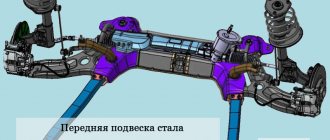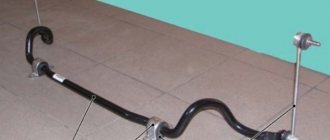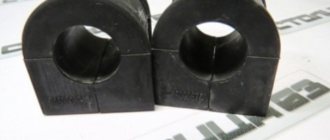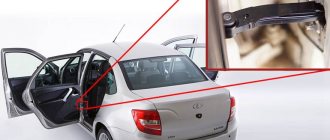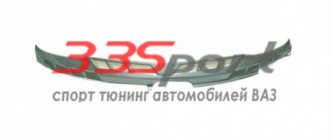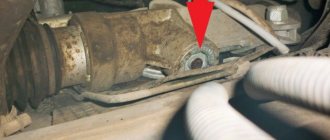If you are not the owner of a newly-made Vesta, then you have probably already encountered the problem of a terrible squeak emanating from the suspension when driving over bumps, especially speed bumps. Let's try to figure out how and where the creaking comes from and how you can deal with it.
Like any new model, Lada Vesta is not without some design flaws, which, fortunately, can be quite easily eliminated with your own hands.
Replacing anti-roll bar bushings on Lada Vesta
Many owners of the Lada Vesta sedan experience creaking in the suspension.
If a squeak appears in the front of the car after overcoming uneven roads, then most likely the source of extraneous noise is the anti-roll bar cushions (bushings). Let's figure out how to replace them with your own hands. The condition of the anti-roll bar cushions is checked visually; there should be no bulging or cracking of the rubber. If you can’t get rid of squeaks by lubricating the bushings, try using other, higher-quality stabilizer pads, for example, polyurethane ones from Niva Chevrolet (article number: 17012680).
Attention! The stabilizer pads should be replaced only when the stabilizer is in a relaxed state (both front wheels are suspended or evenly loaded with the weight of the vehicle).
The diagram shows the Vesta front suspension subframe assembly. The anti-roll bar is marked in red the bushings or cushions are in green the white arrows indicate the location of the bolts that hold the bushings in place with brackets.
- Drive Vesta onto a pit or overpass;
- Clean the bolts securing the stabilizer bar from the bottom of the car;
- Completely unscrew one bolt securing the stabilizer bar mounting bracket. We unscrew the second fastening bolt, which is closer to the steering rack, as far as possible (Torx T40 wrench);
- Move the bracket to the side and remove the stabilizer bushing.
The bolts located on the steering rack side cannot be completely unscrewed, because they rest against the steering rack boot clamps. If there is a need to unscrew them completely, then you can do one of the following:
- Turn the anthers themselves together with the clamps;
- Turn the airbag mounting clamp in a circle;
- Remove the steering rack protection, then loosen the steering rack mounting bolts and lift it up. Or remove the steering rack completely.
Installing a new pillow is done in the reverse order; if necessary, make a cut in the lower part of the pillow. We tighten the fastening bolts to a torque of 180 km. Now all that remains is to change the second stabilizer cushion in the same way. The replacement process is also shown in the video:
By the way, if you modify the mounting brackets, you can replace the bushings faster.
Source
Order of Operations
Important! You can begin repairs if the stabilizer bar is not tense. To do this, the front wheels need to be suspended or the weight of the car is evenly distributed - on a viewing hole or overpass. The place where the work will be performed must be washed
The place where the work will be performed must be washed.
So, the car is lifted with two jacks or driven into a pit, now you can start working:
- Clean the stabilizer bar fasteners from dirt.
- Completely unscrew the stabilizer link fixing nut and move it to the side. The same procedure must be performed on the other side of the machine.
- There is a cover on the steering system casing that protects it from contamination. It needs to be removed. To do this, five bolts are removed.
- Now you can unscrew the two bolts securing the brackets.
- The bracket or clamp is removed from its place.
- Now you can remove the bushing.
- The rod must be thoroughly wiped, and particles from the old bushing must be removed, especially at the fastening points. The operation is repeated for the second element.
- The rod needs to be rubbed with lubricant so that the new parts can easily fit on it and move easily.
- A new element is installed on the rack.
- The bushing moves along the rod to the installation site.
- On site, you need to accurately align the bushing along the axis of rotation and fit.
- The same procedure will be repeated with the second bushing.
- Next you need to do the assembly. It is performed in reverse order.
On a note! The manufacturer recommends carrying out routine maintenance every 25-30 thousand kilometers, but Russian climatic and road conditions make significant adjustments to the condition of car parts. Practice shows that bushings are changed much more often. If there is only a suspicion, you need to inspect the part. If defects are found, replace them immediately, since the car’s handling and road safety depend on it.
Replacing stabilizer bushings on Lada Vesta - do-it-yourself instructions with photos and videos
Almost all owners of these cars, without exception, replace the Lada Vesta stabilizer bushings. Usually, immediately after purchasing a car, the owner begins to notice a characteristic creaking of the suspension in the front end. After searching for the sources of the squeak, it turns out that the culprit is the stabilizer bar rubber. Or rather, the material from which they are made is to blame. Most likely, this is a design miscalculation or another attempt by AvtoVAZ to save money.
Front suspension device
First, let's look at the suspension design and the role of the anti-roll bar in it. The front suspension on the car is independent, with double-acting gas-filled struts complete with barrel springs. Here, for the first time for AVTOVAZ, a subframe appeared, on which the lower wishbones, two engine mounting points and the sensational anti-roll bar were located. It is the latter that we will talk about in this article.
Number six (6) is the anti-roll bar, the purpose of which is to eliminate roll when cornering. It is attached using a rubber-metal structure, which is the culprit of our creaking. When the stabilizer rotates, friction and creaking are generated inside the rubber bushing, which we hear. Below is a photo of the bushing that is installed at the factory.
What can be done to get rid of the creaking of stabilizer bushings on the Lada Vesta?
First, you can simply lubricate the rubber bands with grease. WD-40 or any other similar lubricant will work great. However, over time, the creaking will appear again, as the lubricant will dry out or be washed out. Therefore, the procedure will have to be repeated.
Secondly, you can purchase new stabilizer bushings. But it is far from a fact that this will help or solve the problem forever, since the material itself will remain unchanged. And most likely it will also creak over time.
Thirdly, you can install rubber bands of a suitable size from another car. As practice shows, stabilizer bushings from Chevrolet Niva or Kia Rio (Hyundai Solaris) remain suitable options. From Niva, the bushings fit without any modifications, and in order to install Korean rubber bands, you will need to purchase the clamps themselves for them. However, Nivov rubber bands do not always solve the problem, but when installing rubber bands from Kia or Hyundai, you can completely forget about the squeaking of bushings.
This is what the original stabilizer rubber bands look like in comparison with the rubber bands from the Kia Rio:
Articles for ordering: 548132K100 - bushings, 548141W000 - clamps.
Let's sum up the results
As a result, we received a new solution from AvtoVAZ related to the rigid fixation of the stabilizer bushings on the bar. Now, having installed such a new rod, we lose the opportunity to experiment with bushings.
Stabilizer bushing after 15 thousand mileage
If earlier replacing bushings cost a penny and for this you did not need to disassemble half of the front end, now to replace bushings you need to change them together with the bar ($50) and, most likely, with the stabilizer struts, which is another $50. Therefore, before replacing the barbell with a new model, it is worth considering whether there is another use for this hundred dollars.
Replacing stabilizer bushings Lada Vesta
If we talk about the complexity of the work, then there is nothing complicated at all in replacing the stabilizer bushings on a Lada Vesta. To do everything quickly and correctly, all you need is a little time, tools, and follow our instructions.
It is important to understand that when replacing the Lada Vesta stabilizer bushings, it is necessary to completely remove the load from them. To do this, you simply need to raise the front wheels so that they do not touch the ground. This can be done by lifting the front of the car with two jacks. Or first lift one side and put a stop under it and then lift the second side.
The main difficulty in replacing stabilizer bushings on a Lada Vesta is that without minimal disassembly it is almost impossible to install new bushings. But, if you cut the bushing, you can actually install it without any problems.
So, progress of work. Once the front wheels are in the air, you can gradually begin to do the work. Take the T40 key and unscrew the 2 bolts securing the bushing clamp on the passenger side. We move the clamp to the side, remove the old bushing (thanks to the cut on it, this is very easy to do). We install the new bushing in place. If there is no cut on it, then we make it on a new elastic band. Then we put everything back together in reverse order.
But on the clamp, which is installed on the driver’s side, difficulties arise in dismantling one of the bolts. The fact is that it is completely impossible to unscrew it without dismantling the protective screen. This is not the easiest or fastest activity. Therefore, we will proceed as follows. We unscrew one bolt completely. We do not unscrew the second bolt completely, but about 2/3. This will give us the opportunity to rotate the clamp 180 degrees to remove the bushing and install a new one. That's what we do.
Then we stretch the clamp. At this point, the replacement of the Lada Vesta stabilizer bushings can be considered complete. Now no creaks or extraneous sounds will disturb you, and your Lada Vesta will go over all bumps very quietly and smoothly.
Let's sum it up
We made sure that replacing bushings with your own hands is not considered a complex job. If the entire list of manipulations is performed correctly, then the products are guaranteed to withstand the declared service life or even exceed its value if driven carefully.
When operating the Lada Vesta, it is important to periodically inspect the products and clean them of any dirt that has fallen on the rubber surface. Rubber and polyurethane bushings tend to be particularly sensitive to the effects of engine oil or transmission lubricant.
If there is a leakage factor in the units, then its elimination is guaranteed to protect the bushings from premature wear and destruction
It is also important to pay attention to the creaking
We independently eliminate the creaking of stabilizer bushings on Lada Vesta
As Vesta was used, defects began to emerge, which, in principle, is normal for any new model. Typically, such defects do not in any way affect the safety and other vital parameters of the machine. However, when some little thing constantly annoys, this one begins to irritate. This is exactly the situation with the Vesta stabilizer bushings. Therefore, you need to understand the situation and try to resolve the issue.
Why should it be replaced?
The reasons for the need for such a replacement are obvious:
- A poorly secured knot does not perform its function. The car's lateral roll when turning increases and it becomes poorly controlled. It is unsafe to drive such a vehicle.
- The resulting noise creates severe discomfort. A nasty squeak is heard despite the good sound insulation of the cabin. It becomes especially noticeable at low speeds when overcoming obstacles such as small holes and speed bumps.
What's the matter?
The reason for the dissatisfaction of many Newsmakers is the creaking. It is no secret that the stabilizer bushings of the domestic model very soon begin to creak, and sometimes this happens almost immediately after purchase. There have been cases when the car did not have time to travel even 1,500 km, and some manage to drive without making noise for less than 1,000 km. As for the frequency of squeaking, surveys show that this happens in approximately 60% of cars.
Creaking is typical for many Vestas
This creak can be clearly heard in the video.
It is also worth noting that such a squeak is rarely heard constantly. Usually it appears and then disappears. In this case, the problem is extremely clear - the quality of the material or the manufacturing of the components is not high enough.
In this case, there are two solutions:
- Contacting the dealer;
- Independent work.
In general, both options are working, however, both the first and second have certain disadvantages.
Loose wheel bolts
The situation when the fastening bolts of one or several wheels have become loose is typical not only for Lada Vesta, but occurs frequently. There can be many reasons - from inattention during tire fitting to an unsuccessful attempt to steal a wheel.
If a knocking sound occurs while driving, the first thing you need to do is stop the car and check the tightness of the wheel bolts, since a tire that falls off while turning can cause the car to roll over with unpredictable consequences. In this case, diagnostics is inseparable from troubleshooting.
After tightening the bolts or making sure that the reason for the knocking is not their tightening, you can continue driving. If the problem is not solved, you should not put off diagnosis for a long time. In order not to aggravate the situation when one malfunction causes another, it is strongly recommended to contact an authorized dealer as soon as possible for qualified diagnosis and elimination of the causes of knocking or other abnormal suspension noises performed on a car raised by a lift.
Independent repair of a car before the expiration of the warranty period may be classified by the dealer as a violation of contractual obligations by the consumer and become grounds for premature termination of warranty service.
Contacting the dealer and AvtoVAZ’s position
If you have decided to contact a Lada dealership, you will most likely be unpleasantly surprised. The fact is that the Russian automaker, although it recognized the problem, took the simplest path to solving the issue.
At the dealership, the bushings are lubricated with grease.
The craftsmen do not replace the bushings, but simply lubricate them with PMS 400 grease. To carry out lubrication work, the unit is disassembled and then reassembled. PMS 400 is an emulsion-based lubricant with adhesive properties. It is widely used in defoamers and in plastic-to-metal contact areas. It has hydraulic, shock-absorbing, cooling and damping properties.
The result of using this lubricant is twofold. The Vesta stabilizer bushings actually stop squeaking, but this does not last long. The reason is that the lubricant is quickly washed out (literally within 100-150 km) and the sounds are heard again. This moment is especially pronounced in the fall, during rainy weather.
Radiators (cooling, heating, air conditioning systems): Valeo brand, made in Russia
All three Vesta radiators from the French brand Valeo (a well-known component manufacturer) are distinguished by good workmanship, in no way inferior to their world analogues. During dismantling, it was difficult to suspect that the radiators were assembled in Tolyatti at Valeo’s own production site.
By the way, the competence of the employees of the hotline of the Russian representative office of Valeo (where we were transferred to answer questions) was called into question. They couldn’t say exactly what was being assembled at the Valeo site in Nizhny Novgorod, and when asked about production in Togliatti, we were told that there was no confidence that it was working at all, although the press service of AvtoVAZ firmly confirmed the opposite.
Independent work
In this case, there are several ways:
- Bushing lubrication;
- Replacement with analogues.
Bushing lubrication
If you choose this option, everything is done exactly the same as when contacting a dealership. However, car owners choose the lubricant themselves. Some people buy regular mastic, others use foreign lubricants, for example, Japanese ones.
Owners buy different lubricants
Be that as it may, these are only temporary measures, since mastic and other lubricants are still quickly washed out. It may last a little longer, but that doesn't solve the problem.
Replacement with analogues
According to reviews from owners, most often either bushings from Chevrolet Niva or components from KIA are used.
Bushings from Chevrolet Niva
Elements from this model are suitable for Lada Vesta, which can be bought at almost any car store. In addition, they can be ordered online using the following article numbers:
Stabilizer bushings from Chevrolet Niva
The second type of product has larger dimensions, so it is used more often. The price of bushings from Chevrolet Niva is about 150 rubles per pair. However, there are also polyurethane products on sale, which are often painted in bright colors (yellow, red, etc.). The price of polyurethane products reaches 250 rubles per piece.
You can purchase products from one of the resources below:
- https://www.autopiter.ru/goods/21232906046/rossiya/id51385878
- https://niva-lada4x4.ru/product_info.php?products_id=4152
- https://tankomobile.ru/polyurethan-chevy-niva.html
- https://www.nivashop.ru/catalog.html?idc=420&stype=4
However, Vest owners note that elements from the ChevyNiva also often creak, and it doesn’t make much difference what material they are made of - rubber or polyurethane.
Bushings from KIA
These are more expensive components, which can be purchased under article number KSBSOULF or 54813-2K100. The price for such products is significantly higher than for similar ones from ChevyNiva. Usually the cost varies between 400-650 rubles, but the price can reach 850 rubles per piece. Therefore, it is recommended to monitor offers from various suppliers before purchasing. In this case, you need to buy only original products. Purchasing a non-original one is fraught with the same creaking noise, which is extremely unpleasant, because bushings from a Korean manufacturer are not cheap.
You can purchase them on one of the following sites:
- https://koreanaparts.ru/product/548132K100/730
- https://www.autodoc.ru/part/hyundai-kia—647/548132k100/
- https://www.autopiter.ru/goods/548132k100/hyundai-kia/id11105217
- https://plentycar.ru/autopart/1981834
In addition, it is worth taking into account the configuration of parts from HYUNDAI-KIA, which differs significantly from that of the Lada Vesta. For this reason, along with the bushings, you need to buy brackets for them, which are sold under article number 54814-1G000. The price tag for them ranges from 300 to 500 rubles per piece.
Comparison of Russian and Korean elements
You can order brackets online at the following addresses:
- https://koreanaparts.ru/product/548141G000/730
- https://nomer52.ru/kronshtejn-vtulki-stabilizatora_hyundai_elantra-hd_548141g000_mobis_i126/
- https://www.autodoc.ru/part/hyundai-kia—647/548141g000/
- https://www.autopiter.ru/goods/548141g000/hyundai-kia/id11105233
Bracket for bushings from Kia
We collect
After lubricating the surface of the stabilizer with soap or lubricant, the bushings are installed. They should fit tightly, without play. After making sure that everything is in order, we assemble the unit in the reverse order:
- We install the stabilizer in place.
- We install the brackets securing the bushings. We tighten the bolts securing them.
- We fix the ends of the struts to the stabilizer. We tighten them.
- Only after this do we tighten the bracket bolts with a force of 1.8–2.4 kgf. m. Do not overdo it, otherwise you will break the threads in the mounting holes!
- We install the protective cover of the steering mechanism.
Replacing the Lada Vesta stabilizer bushings is a simple job. If it is done correctly, the service life of the stabilizer bushings will increase several times. You can extend the life of important parts by carefully monitoring their cleanliness and promptly removing contamination. Both rubber and polyurethane elements are especially sensitive to the ingress of engine or transmission oil.
Reviews
| № | Positive |
| 1. | Vasily , 34 years old (drive2.ru) Sverdlovsk: for the first time the seals creaked at 20,000 km, I went to the service station under warranty, the guys lubricated it with a metal-rubber aerosol. A year has passed - silence. |
| 2. | Petrovich , 44 years old (prom.ua), Krasnodar: the car is in its third year, no complaints, the suspension is working as normal. I've heard drivers complain about the crunching noise, but I didn't have that problem. |
| 3. | Alexander , 35 years old (autotoday.com), Omsk: I’m happy with the purchase of the Lada Vesta, I regularly visit the service station, I drive carefully, the speed limit is medium. |
| 4. | Ivanovich , 45 years old (rozetka.ua), Rostov-on-Don: my positive review of the Lada Vesta car in general. Good build quality, relatively cheap spare parts, developed network of car services. |
| 5. | Vyacheslavovich , 43 years old, Kursk (avtoflit.com): my first car was a Lada Priora, after which I bought a Vesta. The difference is noticeable in quality, assembly, and service life. Undoubtedly Lada Vesta is better. |
| 6. | Valery , 33 years old, Voronezh (autotoday.com): in three years of using the car, I visited a service station once to replace stabilizer bushings, not counting scheduled technical inspections. |
| 7. | Vasilievich , 46 years old, Ufa (drive2.ru): I take care of the equipment, periodically go to the inspection pit, check the fastenings and components. Over the course of three years, I lubricated the stabilizer bushings several times. I didn't do any more work on the suspension. |
| 8. | Semenych , 38 years old, Bashkortostan (drive2.ru): The Lada Vesta is well assembled, I’m pleased with the quality. I fix minor damage myself. Even when operating on rough terrain, the suspension absorbs bumps perfectly. |
| Negative | |
| 9. | Dmitrievich , 49 years old (prom.ua), Saratov: Vesta disappointed me, after 30,000 km the stabilizer seals creaked. I visited a service station, the guys lubricated it with an aerosol, and after 5000 km the situation with the “sound” repeated itself again. |
| 10. | Alexey , 46 years old, Moscow (avtoflit.com): in two years of using the car, I went to the workshop three times for suspension maintenance. Constant squeaks and crunches. The quality is raw, the machine has shortcomings that the manufacturer must eliminate. |
| 11. | Filippovich , 39 years old, Voronezh (drive2.ru): my opinion is that the Lada Priora was made with better quality than the Vesta. I bought it a year ago and now I regret it. There are a lot of shortcomings, defects, and expensive spare parts. |
| 12. | Valentin , 37 years old, Pskov (autotoday.com): if you are choosing a car between Lada Vesta and Renault Logan, then consider buying a French brand. |
Installation
In general, the algorithm for replacing standard stabilizer bushings with an analogue one is simple and, by and large, the same for components from the Chevrolet Niva and for parts from KIA. The only difference is that, in the case of parts from KIA, you will have to install the purchased bracket.
As for the Chevy Niva, the bushings from it will need to be modified - it is necessary to make a slot on the side, and then grind the sides down to the same size as on Vesta.
The replacement process itself begins with installing the Lada Vesta on the overpass, after which you need to thoroughly clean the bolts that secure the stabilizer bar from dirt. Next, you need to arm yourself with a wrench and a Torx T40 bit, with which one bolt from the bracket is completely unscrewed (located further from the steering rack). The second bolt is also unscrewed, but not completely, but enough so that the mounting bracket can be moved to the side.
When the bolts are unscrewed, all that remains is to move the bracket and remove the bushing itself. A pre-prepared bushing is placed in its place, and the bolts are tightened. The second element changes similarly.
This method works provided that components from ChevyNiva are used. If you decide to install bushings from KIA, you will have to completely remove the brackets. In this case, simply unscrewing the bolts will not work, since the screw, which is located closer to the steering rack, rests on the clamp that secures the rack boot.
It can be seen that it will not be possible to unscrew both bolts
In this situation there are 4 options:
- Turn the clamp itself;
- Rotate the boot (together with the clamp, of course);
- Remove the rack protection, then loosen its fastening bolts and slightly lift the rack up;
- Remove the rail completely.
This will allow you to replace the bracket along with the bushing.
And also the bracket from it
As you can see, there are several options for getting rid of creaking Lada Vesta bushings, which differ strikingly in both the effort involved and the financial and time costs.
This form provides general recommendations for eliminating squeaks.
There is a problem on the Lada Vesta car: the stabilizer bushings (struts) make a squeaking noise. Needless to say, on modern cars, besides the Lada Vesta, even on expensive ones, the problem of rubber bands is noticeable. The Lada Vesta stabilizer bushings begin to creak well and the struts quickly make themselves known. Creaking, knocking, non-functioning stabilizer bars appear so often on the Lada Vesta car - that AvtoVAZ even answered the question: why Vesta creaks so early. The price for such stabilizer struts and bushings is not high, but the sensations are not pleasant. By the way, the dealer changes the bushings under warranty. What to replace with: as an analogue, stabilizer bars from Kia Rio and Avensis are suitable for Lada Vesta - but this is after warranty. Polyurethane stabilizer bushings have proven themselves better - you can install them. Replacing components with your own hands takes 14 steps, more on them later in the article. The maximum weight of the Lada Vesta is 1670 kg. The Vesta is equipped with MacPherson strut suspension, a suspension that has been tested over years of operation on different types of vehicles. There is an opinion that the car is simply too heavy; for such stabilizers, they should be more powerful. On the Lada Vesta suspension, the stabilizer bushings are simply not slightly modified to accommodate the weight of the car. To understand the problem, let’s understand the principle of operation of the stabilization system of modern cars. There is nothing complicated about this. Everything works on the principle of a lever, which was invented by Archimedes at the beginning of the last millennium, read the article and find out about it
Required Tools
To work you need to prepare the following tools:
- head 10;
- spanner 16;
- hex open-end wrench 16;
- spanner 13;
- two jacks, if there is no inspection hole or overpass;
- Silicone Grease;
- rags.
Replacing the Lada Vesta stabilizer bushings with your own hands is quite advisable, since work in a car service center will cost at least 450 rubles as of 05/31/2019. In addition, you will save personal time and independently audit adjacent components and systems. Faulty bushings are indicated by:
- extraneous noise in the front suspension;
- deterioration in vehicle controllability at speeds of 60 km/h or more;
- the appearance of squeaking when driving through puddles or on roads with uneven surfaces.
Regardless of the reasons (negative impact, aggressive driving, poor quality bushings), if signs of malfunction appear, repairs must be made immediately.
Is it worth installing spare parts from analogues?
Choosing a manufacturer is also not easy - the technology for producing bushings is the same for everyone. Here it is best to rely on your own opinion or the opinion of the one who will carry out the repairs.
Since they are approximately the same for different cars, it is quite possible to install bushings on the Lada Vesta designed for other brands or models of cars. However, you should make a decision to install an analogue only under the pressure of undeniable advantages.
The third-party opinion of a neighbor in the garage should hardly be considered a determining factor. It is much better to listen to the opinion of your auto mechanic or the recommendations of the car factory. The main thing when installing an analogue is that the landing dimensions are maintained.
If you have at least minimal experience working with wrenches, you can save on car service costs by doing the replacement yourself - the work is not complicated, not long or difficult.

